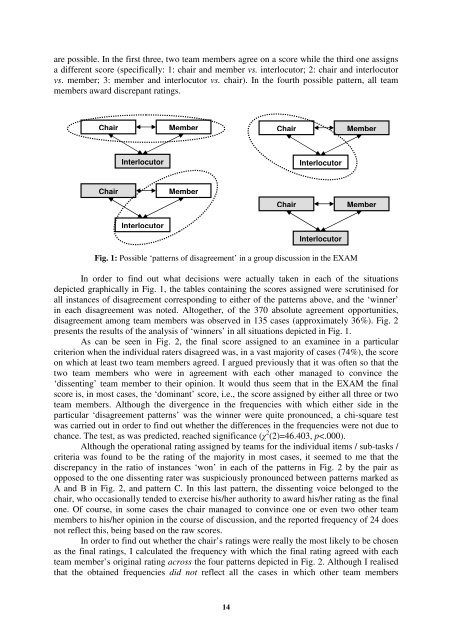Dr Marcin Smolik English Institute Maria Curie-Sklodowska ...
Dr Marcin Smolik English Institute Maria Curie-Sklodowska ...
Dr Marcin Smolik English Institute Maria Curie-Sklodowska ...
You also want an ePaper? Increase the reach of your titles
YUMPU automatically turns print PDFs into web optimized ePapers that Google loves.
are possible. In the first three, two team members agree on a score while the third one assigns<br />
a different score (specifically: 1: chair and member vs. interlocutor; 2: chair and interlocutor<br />
vs. member; 3: member and interlocutor vs. chair). In the fourth possible pattern, all team<br />
members award discrepant ratings.<br />
Chair Member<br />
Interlocutor<br />
Chair Member<br />
Interlocutor<br />
Fig. 1: Possible ‘patterns of disagreement’ in a group discussion in the EXAM<br />
In order to find out what decisions were actually taken in each of the situations<br />
depicted graphically in Fig. 1, the tables containing the scores assigned were scrutinised for<br />
all instances of disagreement corresponding to either of the patterns above, and the ‘winner’<br />
in each disagreement was noted. Altogether, of the 370 absolute agreement opportunities,<br />
disagreement among team members was observed in 135 cases (approximately 36%). Fig. 2<br />
presents the results of the analysis of ‘winners’ in all situations depicted in Fig. 1.<br />
As can be seen in Fig. 2, the final score assigned to an examinee in a particular<br />
criterion when the individual raters disagreed was, in a vast majority of cases (74%), the score<br />
on which at least two team members agreed. I argued previously that it was often so that the<br />
two team members who were in agreement with each other managed to convince the<br />
‘dissenting’ team member to their opinion. It would thus seem that in the EXAM the final<br />
score is, in most cases, the ‘dominant’ score, i.e., the score assigned by either all three or two<br />
team members. Although the divergence in the frequencies with which either side in the<br />
particular ‘disagreement patterns’ was the winner were quite pronounced, a chi-square test<br />
was carried out in order to find out whether the differences in the frequencies were not due to<br />
chance. The test, as was predicted, reached significance (χ 2 (2)=46.403, p



